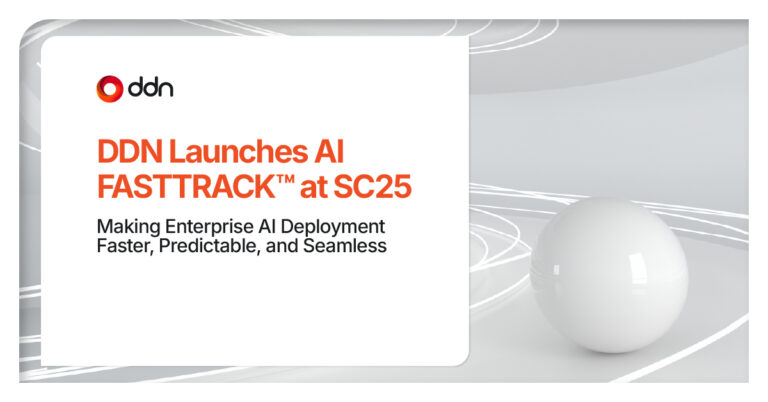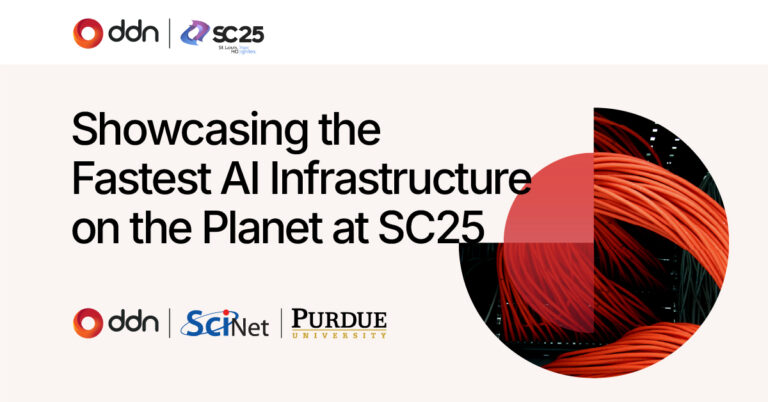Dedicated AI architectures are a complex mix of many different, yet equally important parts working in tandem. Imagine a Formula 1 race car. You can have the most powerful engine on the market, but if you’re racing on tires built for a Prius, that engine won’t save you from having to stop at the pit for maintenance after each lap.
Optimizing these systems requires careful planning and deep technical expertise, which not all of us have. DDN’s AI data intelligence platform is dedicated to those of us who are humbly non-technical and appreciate the simplified version of things from time to time.
In today’s blog, we’ll explore why an unnecessary number of companies are losing millions of dollars on their GPU investments due to inefficient GPU utilization and GPU acceleration.
Unlocking Full GPU Performance: The Big Three Components
- GPUs: The Race Car Engine: The value proposition of the GPU is straightforward: they process the data being passed through an AI model and they do it fast; the race car engine analogy is fitting here. This is where GPU optimization becomes crucial.
- Networking: The Performance Tires: High-speed, low-latency networks ensure that the data we want the GPUs to process arrives to those GPUs without a hitch.
- Data Platform: The Fuel Tank: In AI systems, the data platform isn’t just the fuel tank that holds our precious data. It’s responsible for deciding how data travels to the GPUs, in addition to storing it.
Overcoming Data Platform Bottlenecks: Your Engine is Stalling
The most popular data platform architectures are NAS and NFS, which most providers use, including most of our competitors in the AI data platform space. Both originated and gained popularity around the 1990s and haven’t changed much since.
Simplifying things, both NAS and NFS deliver data to GPUs sequentially, or in a straight line. This means that, for the GPU to process data, each piece of data must be delivered one after the other at the speed of the networking. This is where GPU direct storage can make a significant difference.
Because GPUs are so fast, this often means that there is a waiting period between when the GPU processes a piece of data, and when the NAS or NFS platform delivers the next piece. In other words, our race car’s engine is stalling.
So how do we fix this? By delivering more than one piece of data at the same time to eliminate the waiting period. The kind of architecture that works like this is called a Parallel File System, or PFS, which has been perfected by DDN over the last two decades.
By delivering data to the GPUs in parallel, rather than sequentially, they always have more data to process and won’t waste time sitting idle.
DDN’s Impact: The Numbers Behind GPU Optimization
At DDN, we’ve helped a significant number of customers fix their AI data platform bottlenecks. Here’s a few statistics we’re proud of:
- DDN customers see up to a 99% reduction in processing latency when transitioning from traditional NAS and NFS platforms to DDN’s unique parallel file system, a leading solution among parallel processing unit companies.
- DDN data intelligence platform delivers up to 700% performance gains for AI & Machine Learning workloads.
- DDN technology accelerates over 60% of the global top 100 supercomputers.
- 11,000+ customers benefiting from DDN technology that powers over 500,000 GPUs worldwide.
Ensuring GPU Efficiency: Make Your GPUs Happy
Nobody likes waste. Whether that’s wasted time, effort, money, or in this case, all three. Be kind to your GPUs, your engineers, data scientists, executives, and stakeholders; don’t cut corners when you’re planning out your investments for the AI data platform. Choose DDN for accelerated computing solutions.
Ready to optimize your AI data platform and maximize your GPU performance? Contact an AI specialist today to learn more about how DDN can help you achieve your goals. You can also calculate your potential ROI savings with our GPU Efficiency Calculator
GPU utilization refers to the percentage of time the GPU is actively processing data. High GPU utilization indicates efficient use of the GPU’s capabilities.
GPU acceleration involves offloading compute-intensive tasks from the CPU to the GPU, which can process data faster and more efficiently.
GPU direct storage allows data to be transferred directly to the GPU, bypassing the CPU, which reduces latency and improves performance.
Parallel processing enables multiple data streams to be processed simultaneously, reducing idle time and increasing the efficiency of AI systems.
DDN’s Parallel File System delivers data to GPUs in parallel, ensuring they always have data to process and minimizing idle time. Discover the benefits of DDN’s Parallel File System



